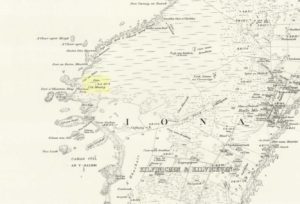Hillfort: OS Grid Reference – NM 2649 2462
Also known as:
- Canmore ID 21638
- Dun Cul Bhuirg
Getting Here
Take the road that cuts across the island, west, until you reach the stupid golf-course. Walk across it, heading for the coast (not the building at Culbuirg), then follow the little footpath up until you reach the large rocky rise about 500 hundred yards north. That’s it!
Folklore

Shown on the 1881 OS map of the region, the small remains of this Iron Age hillfort was said to be the place where St. Columba saw a rain-cloud which he predicted would bring a plague of ulcers to the people of Ireland. To prevent such a plague, Columba thence dispatched a monk called Silnan to Ireland, armed with some bread which he’d blessed. This bread was then dipped in consecrated water and given to those afflicted with the plague, who were thereafter cured.
Wee-ird……
Another tradition told that this old fort was once an important meeting place for the druids, though Geoff Holder (2007) writes that this is little more than a “spurious nineteenth century tradition” which he dismisses as without foundation. Though a short distance from here, he also told how one “Fiona MacLeod” (real name, William Sharp) one night watched the ghost of the Culdee, Oran, a couple of hundred yards away, “and so he never went that way again at night.” In truth, traditions of druidism tend to be animistic traits: legends remembered from pre-christian days, and blanket dismissals of such folklore are themselves untrustworthy—especially on this Isle of the Druids.
References:
- Holder, Geoff,The Guide to Mysterious Iona and Staffa, Tempus: Stroud 2007.
- MacLeod, Fiona, Iona, Floris: Edinburgh 1982.
© Paul Bennett, The Northern Antiquarian
While volunteering at Kelvingrove Museum in Glasgow, I was lucky enough to be able to examine a collection of Late Iron Age (I think) glass beads excavavated at Dun Bhuirg in one the digs in the 1970s. Clambering about the rocks as a stude in 1990, I could see some of the vitrified stone defences. Would definitely recommend Dun Bhuirg as a sunbathing spot during the day. There are several well written up excavation reports available online, but don’t let them damper your imagination too much folks . . .